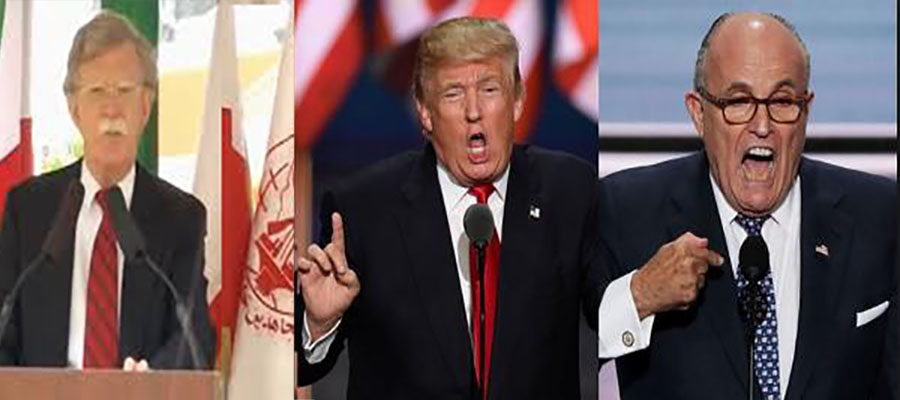Since unprecedented protests erupted across major Iranian cities last month, the People’s Mojahedin Organization of Iran, or the Mojahedin-e Khalq (MEK), has sought to capitalise on such complicated developments to push Donald Trump’s administration more in favor of the group’s regime change agenda. Whereas Republicans were quick to criticize former US President Barack Obama’s diplomatic overtures to Iran and decision to avoid overtly supporting any factions in Iran pushing for the Islamic Republic’s overthrow during the 2009 protests, voices on both sides of Washington’s partisan divide have urged Trump to embrace a new approach towards Tehran.
A host of pundits are calling on Trump to support the MEK as a viable, democratic, pro-Western, and secular alternative to the Islamic Republic, despite the fact that the State Department designated the faction a terrorist organization from 1997 to 2012 for its “past acts of terrorism, including its involvement in the killing of US citizens in Iran in the 1970s and an attack on US soil in 1992.” Nonetheless, since Trump won the 2016 presidential election, scores of former US officials have sought to convince him to open up discussions between his administration and the MEK.

Dr Khalid Al-Jaber & Giorgio Cafiero
Although, thus far, Trump’s administration has been quick to distinguish itself from Obama’s by assertively condemning the Iranian regime and expressing solidarity with Iranian protesters, it is not clear if the administration will heed advice in favour of supporting the MEK. Andrew Peek, Deputy Assistant Secretary of State for Iraq and Iran, stated that the administration will not pursue regime change in Tehran, but instead seek to pressure the Islamic Republic into changing its conduct.
The administration, however, is still issuing thinly veiled threats suggesting that regime change might be in the cards. At Press Secretary Sarah Huckabee Sanders’ first brief of 2018, she said that the Trump administration is “keeping a lot of options on the table at this time”. State Department spokeswoman Heather Nauert asserted that sanctions are only one part of Washington’s “tool kit” and that “there are a range of options that we have going forward.” In June, Secretary of State Rex Tillerson affirmed at a House Foreign Affairs Committee hearing that Washington’s Iran policy is based on supporting “elements inside of Iran” in pursuit of a “peaceful transition of that government”.
Unquestionably, Washington turning to the MEK to promote the overthrow of Iran’s regime would signal even more of a departure from Obama’s strategy towards Tehran. But doing so entails high levels of risk. To be sure, the White House backing the MEK would emboldened the Iranian regime’s narrative that the unrest in the country’s major cities is orchestrated by Tehran’s “enemies” including the MEK, as well as the US, Israel, and Saudi Arabia.
Regardless of how unrealistic it is to imagine the MEK having the means to topple Iran’s regime, any effort to trigger the Islamic Republic’s collapse could fuel a major escalation of violence throughout the Middle East. In light of Saudi Crown Prince Mohammed bin Salman’s assertion in May 2017 that any military confrontation between Riyadh and Tehran would take place “inside Iran, not in Saudi Arabia”, coupled with Prince Turki bin Faisal Al Saud’s endorsement of the MEK two months later, tensions between Saudi Arabia and Iran have reached a dangerously high level that would likely impact Tehran’s response to any foreign-sponsored efforts to topple the regime.
Of course, Iran’s ability to retaliate against any of Washington’s efforts to decisively back the MEK could create major dilemmas for the US military’s various bases around the region. Having spent years expanding its influence throughout the Levant and Arabian Peninsula, Iran is in a position to order Tehran-backed militias to carry out violent attacks against US installations in numerous countries near Iran. In Iraq and Syria, where various actors are seeking to make themselves shareholders in the future of both countries, Iran has extensive clout that can be directed against Washington in the aftermath of the Islamic State’s defeats last year. Put simply, as the majority of Americans favour diplomacy towards Iran, such actions against the regime could drag the Trump administration into new conflicts and quagmires in the Middle East that would likely be highly unpopular among the US public.
It is important for the Trump administration to react to protests in Iran carefully, without taking actions that could further undermine US interests in the country and elsewhere in the region. Given that there is widespread opposition to Trump across Iran’s political spectrum—largely due to his opposition to the Joint Comprehensive Plan of Action (JCPOA) and his administration’s inclusion of Iran on last year’s travel ban, it remains to be seen how Trump’s expression of solidarity with Iranian protestors will pan out on the ground in Iran.
In any event, support for the MEK, a group that carries much baggage in Iran for its history of collaborating with Saddam Hussein in the Iran-Iraq war, would almost inevitably fuel greater opposition and anger towards Trump and the US on the part of both Iranians who are supportive of their regime and those calling for Iran to transition away from the Islamic Republic nearly four decades after its establishment.
The peninsula qatar.com

